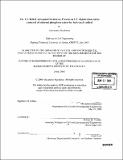The UV/H2O2 advanced oxidation process in UV disinfection units : removal of selected phosphate esters by hydroxyl radical
Author(s)
Machairas, Alexandros, 1980-
DownloadFull printable version (5.460Mb)
Other Contributors
Massachusetts Institute of Technology. Dept. of Civil and Environmental Engineering.
Advisor
Bettina M. Voelker.
Terms of use
Metadata
Show full item recordAbstract
In this work, the issue of how to remove phosphate esters from drinking water is examined. From the various treatment processes available, the oxidation of phosphate esters through hydroxyl radical generated by the UV/H202 process applied at a UV disinfection unit was selected for evaluation. The second-order rate constants of the reactions of two phosphate esters, Tri(2-butoxyethyl) phosphate (TBEP) and Tri-2-chloroethyl phosphate (TCEP) , with hydroxyl radical were estimated from our experimental data to be 2.1000 M-1s-1 and 2 109 M-is-1 respectively A comprehensive kinetic model of the oxidation process was derived. Finally computer simulations were used to exhibit the potential of this treatment process and to examine the effects of pH, total carbonate species concentration, initial hydrogen peroxide dose, and light intensity on its efficiency. The results are not very encouraging when a UV unit designed for disinfection is used. For typical values of pH and total carbonate species (pH=8 and CT=5' 10-4 M) the 1 s order rate coefficients for removal of the phosphate esters are 6.3 10-4 (s-1) for TBEP and 6.3 10-5 (s-1) for TCEP. If higher light intensity is applied in the reactor (50 times higher), and initial hydrogen peroxide dose of 10-3 M and CT remains 5 10-4 M, the 1st order reaction rate coefficients become 2.9 10-2 (s-1) and 2.9-10-3 (s-1) for TBEP and TCEP respectively.
Description
Thesis (M. Eng.)--Massachusetts Institute of Technology, Dept. of Civil and Environmental Engineering, 2004. Includes bibliographical references (leaves 96-97).
Date issued
2004Department
Massachusetts Institute of Technology. Department of Civil and Environmental EngineeringPublisher
Massachusetts Institute of Technology
Keywords
Civil and Environmental Engineering.